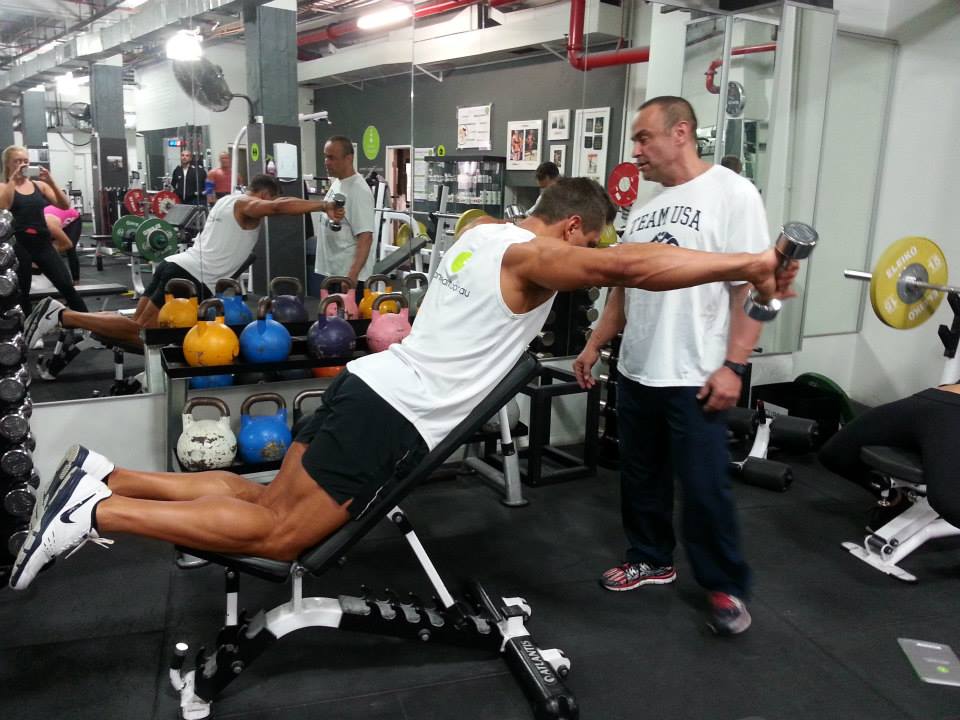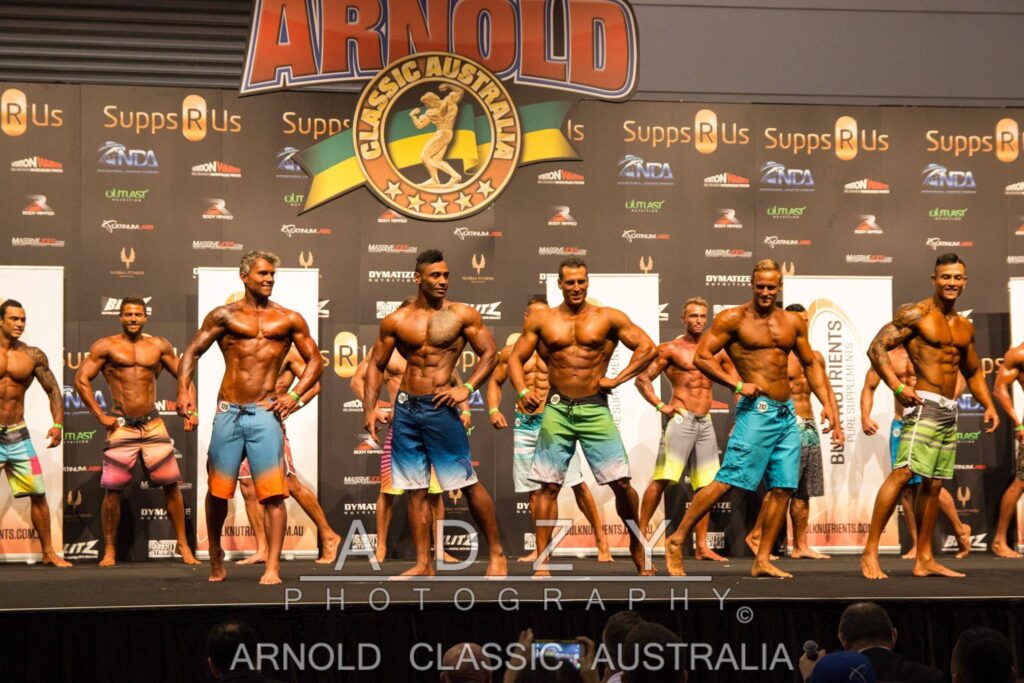I have read all his books and articles, and have attended all of his courses and seminars.
Last week when I received the shocking news that Charles had suddenly passed away, it was a very devastating moment for me.
Not only did I lose one of my great mentors and role models but I also lost a friend, and someone that was like an uncle to me.
Even though Charles is no longer with us on this planet, his legend and his legacy will continue to live on through the likes of his students and like myself and many others.
I consider myself most fortunate because not only did I get to travel with Charles and help him teach at some of his courses but I was also one of his only students to get coached by him directly.
In 2015 I hired Charles to prep me for the Arnold Classic Australia Men’s Physique division. It cost me an arm and a leg but it didn’t matter because now I wouldn’t trade that experience for anything and it put me ahead of the curve.
Charles helped me put on 6kg of stage weight in only 4 months and I learned more about my body in those 4 months than in my entire training career before then.
Even long after I finished the coaching with Charles I continued to use the principles he taught me to learn more and more about my body and refine my blueprint further.
Before Charles I had already worked with some of the best coaches in the world. Since then I’ve been on my own because now I understand my own body better than anyone else.
As the old saying goes “Give a man a fish and you feed him for a day. Teach a man to fish and you feed him for a lifetime”.
That is what Charles did for me and that is why I consider him the best coach that I have ever worked with.
I originally wrote this article back in 2015 after I had finished up with Charles as testimony for him to put up on his strength sensei website. It was my way of showing my appreciation for what he had done for me. After all Charles wasn’t coaching any clients at that time and he did me a great favour by accepting to take me on.
Now in his passing I feel the obligation not only to repost this article in its original form but also to expand on it further and continue spreading his work and keeping his legacy going.
Please do me a great favour and if you enjoy this article share it with all your friends so we can all do our part in keeping Charles Poliquin’s legacy alive…because LEGENDS NEVER DIE!
So without further ado lets get into it and let me share with you my experience and the principles that I learned while working with Charles that still serve me to this day.
1. The Art of Coaching
Coaching is part art and part science. A good coach can determine what a client needs and prescribe the right training, nutrition and supplementation plan based on their physiology and psychology.
In my opinion no one did this better than Charles. He had a third eye for knowing exactly what an athlete needs at any given point in time and that come from decades of experience.
Even though he was known for popularizing concepts like low carb nutrition and accumulation-intensification periodization, he did not use a one size fits all approach. Charles was all about individualization. He looked at things like past training and diet history, neurotransmitter dominance, hormonal profile, muscle fiber type, and strength ratios to name a few.
He had me routinely consuming between 400 to 600g of carbs per day (even when my body fat shot over 10%), he counted macros, and he did not use the accumulation-intensification model with me.
Without my knowing, the first cycle was deliberately intended to overtrain me in order to access my workload tolerance. From there he planned out the rest of the cycles and adjustments in volume and intensity were made based on feedback such as drop off index, load increments from workout to workout, and psychological and physiological biofeedback cues.


The first day Charles took me through to a workout in the morning to assess my strength and work capacity. He then sent me my program within a few hours and said you are training again tonight.
In that first cycle I was training twice a day every 4 days out of 5. Each body part was hit twice in that 5 day period with about 20 to 25 total working sets. Usually the morning session was functional hypertrophy while the evening session was more volume oriented.
After 2 rotations he had me deload by reducing the volume in the morning session by about 60% and eliminating the evening session altogether. During the deload he had me increase calories by 50% so I went from 4000 cals up to 6000 cals.
After the deload and refeed I went back up to full volume but did not experience the supercompensation effect that we had anticipated. I felt sluggish, my body fat had increased, and my lifts weren’t up by much.
He pulled me off that program and we went into the next mesocycle. This time around he had me training twice a day every 5 days out of 7. Each body part was being hit twice in seven days again with about 20 to 25 sets total sets.
Again I made very good progress in terms of load progression from the first to the second microcycle and descent progress from the second to the third microcycle. The third microcycle was a deload again, and apart from the shoulders I didn’t make much progress on any other body part from the third to the fourth microcycle.
The following mesocycle Charles tried a different model. Up to that point we knew I tend to make good progress for the first 3 workouts of a new cycle but then I would hit a wall, and deloading didn’t seem to help.
In this phase I was training twice a day every 3 days out of 5 but instead of deloading on the third microcycle he had me switch to a completely different system.
The volume and intensity were similar but I was using different exercises and rep schemes. This was still part of the same mesocycle which he called cycle B.
After two rotations on cycle B he had me switch back to cycle A and lo and behold my progress shot through the roof! No delaoding was necessary. Deloading actually had an adverse effect on me in that it made feel me sluggish and it was hard for me to get my head back in game after coming off a deload.
I needed a complete change up in stimulus after 2 rotations on a program to avoid building up too much neural inhibition and burning out, then I could return to the same program again.
This is what Charles referred to a hybrid Acetyl Choline/Dopamine neurotransmitter profile. Originally he was training me more like a pure Acetyl Choline type. Acetyl Choline types tend to burn out quickly because they push themselves too hard so you generally need to hold them back every third workout.
But for me the deloading wasn’t enough. I needed more of a change up in stimulus which is more of a Dopamine trait. Pure Dopamine types do best changing up their workout at every session. I did really well repeating a workout before switching up hence how he determined I was more of a hybrid type.
That third mesocycle I made the most progress in terms of size and strength and I enjoyed it the most. The fourth mesocycle we shifted focus to dropping body fat while maintaining size.
Because I had a quite a bit of body fat to drop we had to use a pretty aggressive approach. I was sitting at a little over 10% body fat and I needed to be about 4-5% on stage.
We shifted to training 4 days out 5. I would do weights in the morning which consisting of 4 exercises per body part done for only 2 sets each. Then in the evening I would do strongman training. My carb intake dropped right back from 400g per day to only 50g in the evening.
When you reduce calories so aggressively you have to pull back your weight training volume or you won’t recover properly. We made up the volume with strongman training which is a lot easier to recover from since there is no eccentric component.
At the end I ended up dropping to just under 6% body fat in only 4 weeks. It wasn’t my best condition on stage by any means but I had a lot more size. I was 6kg heavier than my previous show. The outcome of the show wasn’t as important to me as the size I gained and what I learned in the process.

Even though I didn’t place in my show because my conditioning was not quite there it didnt matter. In my next show I gave myself a little more time to get leaner while maintaining my size and I placed 1st.
Charles was the only coach that I’ve had to date that monitored my loads and biofeedback at every workout and made day to day adjustments to my plan. A practice that I have now adopted with all of my online clients.
He taught me that being a good coach as opposed to just being a regular trainer is about carefully observing, communicating effectively with your clients by asking the right questions, listening, taking onboard what they say, and having the knowledge and skills to make adjustments that will help them continue to make progress.
That was one of the main things that I took away from working with Charles.
2. Concentrated Training Blocks
The other thing I took away was realizing the power of concentrated blocks of training.
Charles was famous for producing astounding results with his athletes in record time.
After all throughout his career he only had on average about 12 weeks in the off season to get an athlete strong and in shape so he had to become a master of writing routines that produce results in the shortest time possible.
That’s accomplished through concentrated training blocks termed super accumulation or overreaching.
There in a finite capacity to the amount of strength and muscle mass an athlete can gain in a year. However an athlete doesn’t necessary have to train all out year around to attain those results.
Through concentrated training blocks typically including multiple training sessions per day an athlete can make a lot of progress in a very short amount of time. Of course this rate of progress is not indefinite and is typically followed by a long period of stagnation or maintenance as the bodies adaptive capacity had been exhausted.
In fact as you saw my 6kg lean mass gain came about in the first 12 weeks of the cycle. The last 4 weeks was spent maintaining lean mass while dropping a bit of excess body fat that had accumulated.
I think for most of the population the majority of time should be spent focusing more on basic training methods that bring about slow and steady progress. This type of progress tends to build ones base and is more sustainable long term.
In fact that’s exactly the type of plan Charles put me on after the concentrated training block. After we finished the training he gave me a program where I was only training once a day every 3 days out 5 and averaging only about 8 to 13 sets per body part.
Later that year when I went on tour with Charles to help him teach I got to actually train with him as opposed to being trained by him. The thing that stuck out to me when I trained with him was that he hardly took any of his sets to failure.
He would usually start out very light and add weight each set until he was near max on the last set.
When I asked him why he did that, his reasoning was that because he was older (he was 54 at the time), he doesn’t recover like he used to, and he also needed to look after his joints more.
He said whenever he was trying to put on as much muscle as possible in the shortest time he would train twice a day and take the majority of his sets close to failure. The rest of the time he would train like I described above.

Hitting a biceps shot with the master after an arm workout in Manchester.
That was definitely another big take home point for me as previously I was always trying to push myself too hard all the time and as a result I had stagnated for few years.
It’s something that I see with so many other people also. They have been smashing themselves too hard for too long that they haven’t made any progress in ages because they are so burned out.
These days I only do concentrated blocks about 8 weeks out from a competition and the rest of the time I purposefully hold back and focus on slower progression.
It has worked great for me because even though I didn’t win my show when I prepped with Charles, the lessons that I learned and took away from working with him helped me win the next show for which I prepped myself.
For that I will always be grateful to Charles because he was the one that gave me the confidence and skills to be able to go out and do that on my own.
I will undoubtably continue to miss him as time passes by, but I will never forget him and how he impacted my life.
Rest in peace Charles R Poliquin.





